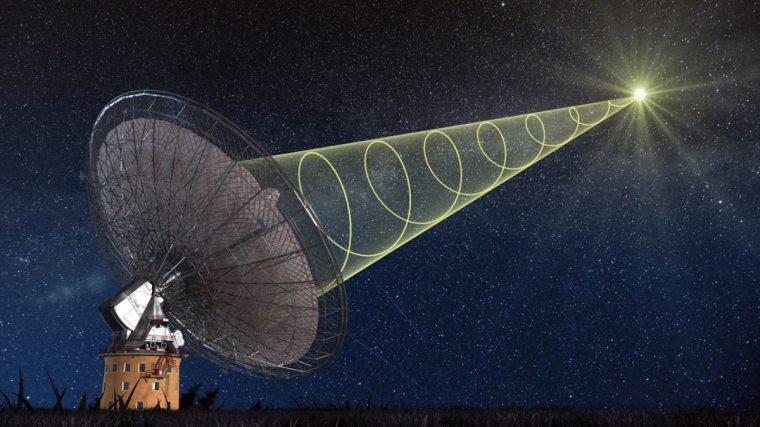'Alien' Radio Signal 5.5 Billion Light Years From Earth Caught In Real Time In Australia

For the first time, an Australian scientist has seen live a radio signal from space beyond our Milky Way galaxy, which could be 5.5 billion light years away.
PhD student Emily Petroff of the Swinburne University of Technology saw the fast radio burst, flash of radio waves from an unknown source, using the 64-meter Parkes radio telescope of the Commonwealth Scientific and Industrial Research Organisation in eastern Australia.
The first such radio burst, lasting only milliseconds, was discovered back in 2007 by astronomers looking through old Parkes data archive.
The Australian scientific body said six more radio bursts outside the galaxy were detected using the telescope and a seventh by an Aracebi telescope in Puerto Rico.
"These bursts were generally discovered week, months or even more than a decade after they happened. We are the first to catch one in real time," said Petroff.
Petroff had an international team of astronomers to make follow-up observations.
When the burst went off, the team swung into action on 12 telescopes in Australia, California, Canary Islands, Chile, Germany, Hawaii and India, and the Swift Gamma Ray Burst Explorer in space.
"We can rule out some ideas because no counterparts were seen in the optical, infrared, ultraviolet or X-ray," said Dr. Simon Johnston, assistant director of Astrophysics of the Commonwealth Scientific and Industrial Research Organisation.
"However, the neat idea that we are seeing a neutron star imploding into a black hole remains a possibility," he said.
The distance of the fast radio bursts are still unknown but it is estimated that it could be up to 5.5 billion light years away.
"This means it could have given off as much energy in a few milliseconds as the Sun does in a day," said Petroff, adding that the origin of the fast radio bursts could be identified.
"We've set the trap. Now we just have to wait for another burst to fall into it."
The findings have been published in the monthly notices of the Royal Astronomical Society.
 Christians don't have to affirm transgenderism, but they can’t express that view at work: tribunal
Christians don't have to affirm transgenderism, but they can’t express that view at work: tribunal Archaeology discovery: Medieval Christian prayer beads found on Holy Island
Archaeology discovery: Medieval Christian prayer beads found on Holy Island Presbyterian Church in America votes to leave National Association of Evangelicals
Presbyterian Church in America votes to leave National Association of Evangelicals Over 50 killed in 'vile and satanic' attack at Nigerian church on Pentecost Sunday
Over 50 killed in 'vile and satanic' attack at Nigerian church on Pentecost Sunday Ukrainian Orthodox Church severs ties with Moscow over Patriarch Kirill's support for Putin's war
Ukrainian Orthodox Church severs ties with Moscow over Patriarch Kirill's support for Putin's war Islamic State kills 20 Nigerian Christians as revenge for US airstrike
Islamic State kills 20 Nigerian Christians as revenge for US airstrike Man who served 33 years in prison for murder leads inmates to Christ
Man who served 33 years in prison for murder leads inmates to Christ


 Nigerian student beaten to death, body burned over ‘blasphemous’ WhatsApp message
Nigerian student beaten to death, body burned over ‘blasphemous’ WhatsApp message 'A new low': World reacts after Hong Kong arrests 90-year-old Cardinal Joseph Zen
'A new low': World reacts after Hong Kong arrests 90-year-old Cardinal Joseph Zen Iran sentences Christian man to 10 years in prison for hosting house church worship gathering
Iran sentences Christian man to 10 years in prison for hosting house church worship gathering French Guyana: Pastor shot dead, church set on fire after meeting delegation of Evangelicals
French Guyana: Pastor shot dead, church set on fire after meeting delegation of Evangelicals ‘Talking Jesus’ report finds only 6% of UK adults identify as practicing Christians
‘Talking Jesus’ report finds only 6% of UK adults identify as practicing Christians Mission Eurasia ministry center blown up in Ukraine, hundreds of Bibles destroyed: 'God will provide'
Mission Eurasia ministry center blown up in Ukraine, hundreds of Bibles destroyed: 'God will provide' Church holds service for first time after ISIS desecrated it 8 years ago
Church holds service for first time after ISIS desecrated it 8 years ago Burger King apologizes for 'offensive campaign' using Jesus' words at the Last Supper
Burger King apologizes for 'offensive campaign' using Jesus' words at the Last Supper Uganda: Muslims abduct teacher, burn him inside mosque for praying in Christ’s name
Uganda: Muslims abduct teacher, burn him inside mosque for praying in Christ’s name